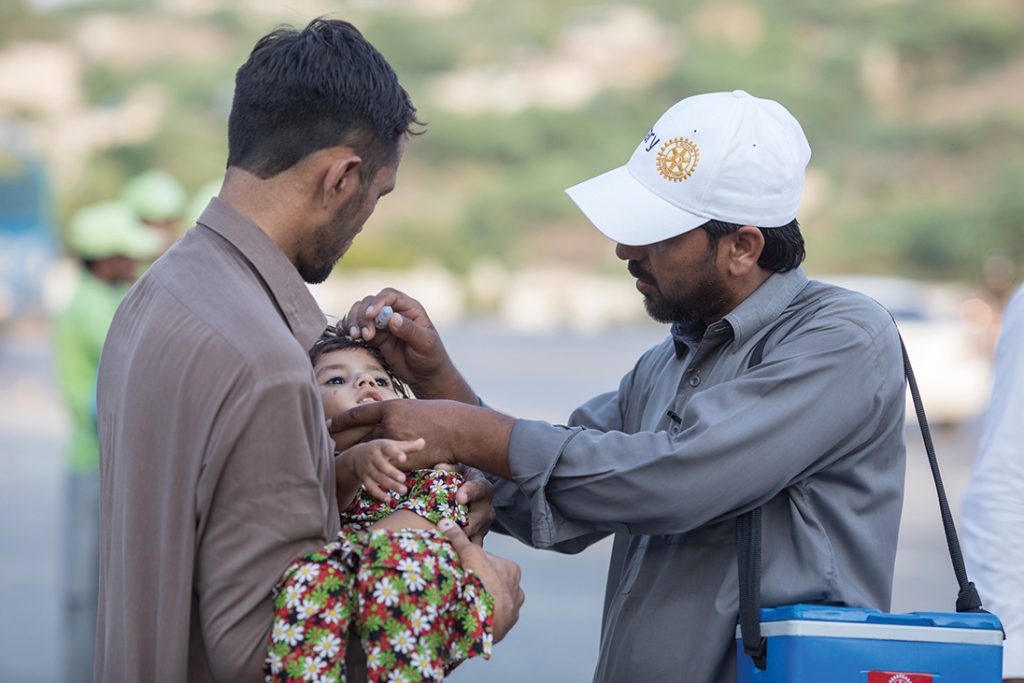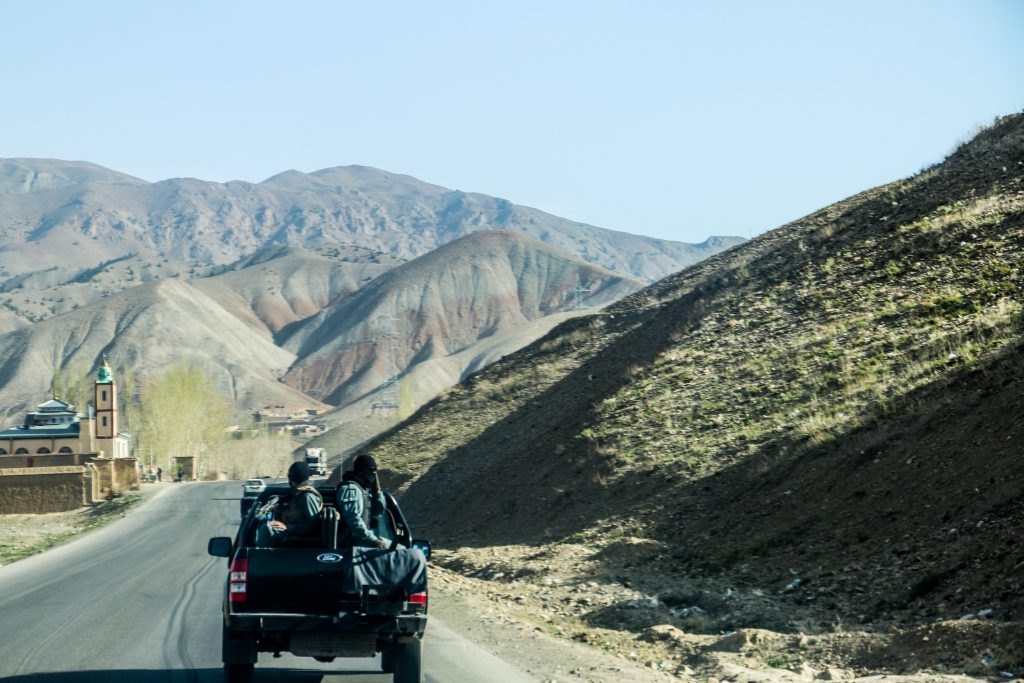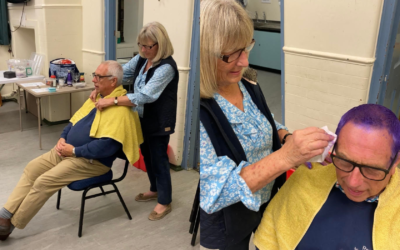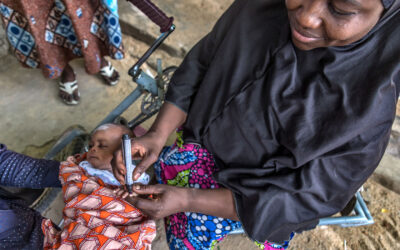How would you characterise 2022 as far as polio is concerned – has it been a set-back year?
No, although at first glance it would appear that way. You may have seen that there have been high-profile detection of polio recently in settings such as London, New York, Israel and Ukraine.
Any time you find poliovirus in a previously polio-free area it is of course a concern and more than anything, it is tragic for the individuals affected and their families. But programmatically, in terms of achieving a polio-free world, such events more than anything are a warning of what would happen if we do not eradicate polio. We would see global resurgence of the disease.
Think of what is happening in London, New York, Israel and Ukraine, but remember how far we have progressed from the start of this journey when we recorded 1,000 cases per day.
From a pure programmatic perspective, our priorities remains eradicating wild poliovirus in Pakistan and Afghanistan and interrupting transmission in the primary sources of circulating vaccine derived polio viruses in northern Nigeria, eastern DRC, south-central Somalia and northern Yemen.
And here, the news is actually extremely encouraging this year. Both countries in fact are treated as a single epidemiological block.
Success means that no child will ever again be paralysed by any poliovirus anywhere in the world.”
Pakistan remains from a purely technical point of view the greater challenge, simply by virtue of the fact that it is the larger of the two countries based on population-size (poliovirus is a virus which thrives in larger populations).
Afghanistan had previously already eradicated its wild poliovirus, and to a certain degree, its fate will always be closely tied to Pakistan’s efforts. In both countries, wild poliovirus transmission has for the past 12-24 months been at extremely low levels. Perhaps the lowest levels we have ever seen.
Pakistan is this year seeing an increase in new cases, but this outbreak is geographically restricted. And the country, led by the highest political leadership, is intensifying efforts to urgently stop this outbreak, while ring-fencing it in to prevent it from spreading to other areas.
Malawi and Mozambique have Significant progress has been made in Nigeria and Somalia and intensive outbreak is underway in Democratic Republic of Congo, and we are pushing hard for access to protect unvaccinated children in northern Yemen.
The reality remains that we now have perhaps the best opportunity ever to finish the job of polio eradication. Or at the very minimum, to firmly cement the ground-stone secure lasting success.
We are – for all the London’s, New York’s, Israel’s and Ukraine’s – probably in the best-ever possible situation. We have a unique window of opportunity – but we must use it, because it will not remain open forever.
The Global Polio Eradication Initiative launched its strategic plan “Delivering on a Promise: Polio Eradication Strategy” which has two main goals of interrupting the transmission of wild poliovirus in the two remaining endemic countries, as well as stopping outbreaks of circulating vaccine-derived poliovirus. How well is this four-year plan progressing?
What this plan does, is it lays out the roadmap to achieving and securing a lasting world, where no child will ever again be paralysed by any poliovirus (be it wild- or vaccine-derived), anywhere.
We have all the tools, and all the tactics. What we now need are for those tactics and strategies to be fully implemented, everywhere, and for the resources needed to be rapidly mobilised.
If those two factors come together, success will follow, we have seen it everywhere else in the world. To achieve success is now a matter of political and societal will.
Success means that no child will ever again be paralysed by any poliovirus anywhere in the world, and the world will benefit from significant economic benefits. So also from a purely health economic point of view, your ‘best buy’ is to ensure eradication.
Failure to eradicate polio will result in global resurgence of the disease. Economically too, this would have a devastating impact. The economic benefits of a polio-free world would be lost, we would need to continue with outbreak response and global surveillance efforts, associated rehabilitative costs, etc. This is an epidemic prone disease, and it cannot be controlled. If we did not know it before COVID, we certainly know now how quickly infectious diseases spread across the world – polio will be no exception.


“Pakistan is this year seeing an increase in new cases, but this outbreak is geographically restricted. And the country, led by the highest political leadership, is intensifying efforts to urgently stop this outbreak, while ring-fencing it in to prevent it from spreading to other areas.”
It is our ‘choice’ whether we choose to eradicate polio, or not. Most diseases cannot be eradicated. Polio is one of the few diseases that can be biologically and technically eradicated.
A number of human disease eradication efforts have been attempted: two are ongoing (polio and guinea worm), one succeeded (smallpox), the others all failed due to technical reasons (they did not know how to conduct disease surveillance, did not have tools such as vaccines, etc).
With polio, we do not have that excuse. If we fail, we cannot point to medical or technical issues. It will be only because we did not mobilise the political will and resources necessary to achieve success.
We will then also have to live with the consequences of that choice. Let us make the right choice.
In October, Rotary and other partners such as the Government of Germany are hosting a global polio pledging moment at the World Health Summit and it is perfect opportunity for international partners everywhere to come together to recommit to this effort, and we hope of course that the Governments of the UK and the Government of Ireland will join their Rotary friends at this event too.
What are your thoughts on the fresh polio outbreaks in Africa this year?
I think you are referring to the wild poliovirus detection in Malawi in February, and subsequently in Mozambique in May. Again, to me this underscores the risk of polio anywhere, to countries everywhere. Africa was certified free of wild poliovirus in 2020, but has been re-infected.
The strain detected in south-east Africa originates in Pakistan. Countries across south-east Africa immediately launched a multi-country emergency outbreak response, in response to this new outbreak.
Three multi-country campaigns have already been implemented to reach more than 20 million children in the subregion, and further campaigns are planned.
Surveillance efforts have been intensified and efforts are underway to strengthen the routine immunisation system where needed. I am confident that this outbreak can be rapidly stopped again.
But as with London and New York: we have to be very clear that such outbreaks will always occur, unless we succeed in global eradication of the disease. The humanitarian and economic consequences of failure would simply be too great. And the faster we achieve our goal, the less chances there will be of seeing new outbreaks such as this one.
Twelve months on from the Taliban taking over in Afghanistan, how is the WHO’s work progressing there?
It remains of course extremely challenging, difficult and even dangerous. The humanitarian situation across the country is acute and dire. The country was recently hit by a devastating earthquake.
Purely from a polio point of view, for the first time in more than three years we are able to reach all areas of the country with polio vaccines. So purely from a polio eradication point of view, this is encouraging. But we cannot operate in isolation, we cannot ignore the broader humanitarian situation.


“The humanitarian situation across the country is acute and dire. The country was recently hit by a devastating earthquake.”
If we deliver polio vaccine, it has to be delivered in a broader package of humanitarian aid, along with food, medical supplies, water, etc.
Similarly, right now, our polio teams on the ground are focusing primarily on supporting the humanitarian emergency relief efforts following the devastating earthquake.
It is an extremely challenging, ever-evolving geo-political and now even geological situation, and we must adapt to these changes rapidly and effectively. I believe our teams on the ground are doing exactly that and making great strides to ensure that each and every child is protected.
Despite the infections in Pakistan this year, what work is going on there to eliminate the polio virus? After so long without infections, how much of a setback was it?
We have seen more wild polio cases this year than last year, that is true. This is tragic, particularly of course for the children and their families who are affected.
The outbreak is clearly explosive but localised to date. Authorities are responding in emergency mode: not only to stop this outbreak but indeed to ring-fence it and prevent it from spreading to other areas.
When you are trying to eradicate an infectious pathogen, you have to interrupt the person-to-person spread of this virus, to give it nowhere to go. There is virtually no room for error.
And we have seen similar phenomenon during the last stretch in other countries, notably India in 2011, and Nigeria in 2016, where suddenly – after a long time with no detected virus – a final cluster of cases would emerge.
So to me, it is also an indicator that Pakistan is getting ever closer. As tragic as these cases are, we must know about them. We have to know about every poliovirus which might be hiding anywhere now so that we can react to it with urgency.
So as paradoxical as it might seem, timely detection of these cases is actually a ‘good’ thing, from a purely programmatic point of view.
We knew there was continuing low level transmission of the virus because we kept detecting it from environmental samples.
Now we have final confirmation of what we already knew, and are able to react to it. But for sure, clearly there are remaining immunity gaps, there remain ‘zero-dose’ children, and we have to find them and reach them, and we have to be better and quicker at finding them than the poliovirus is.
What is the situation in Ukraine with polio? – it is among 28 outbreak countries at risk of re-infection
The situation in Ukraine is obviously horrific, and we are all shocked at the events unfolding there, so close to our doorstep.
For many of us from western Europe, it brings back tragic spectres of the past, which we had thought had been banished to the past. In all honesty, polio is the least concern for people in Ukraine.
Health services are devastated and are focusing primarily on emergency health provision. Poliovirus was last detected in Ukraine in December.
Outbreak response had already been implemented in late 2021, and continued in early 2022 before it was then disrupted in February.
Immunisation services are slowly picking up again, as is disease surveillance to a limited degree, but both remain extremely disrupted.
We work of course with bordering countries, both on immunisation and surveillance, including testing of healthy individuals. Not just for polio but for a broad range of infectious diseases.
We are not detecting poliovirus. Also, the harsh winter climate of Ukraine is very unconducive to poliovirus transmission. I think really that is all one can say unfortunately about the situation – anything beyond that would be pure speculation.
There are seven key countries at risk of polio infection, including China, where there is a low level of immunity and surveillance. What work is going on there?
I think really what the London and New York events show is that there is no country which is not ‘at risk’ of re-infection or re-emergence, whether they are on an official ‘at risk’ list or not.
Our guidance remains the same: until polio is eradicated, the best thing countries can and should do is have strong disease surveillance and strong vaccination coverage ie: identify and assess a public health risk quickly to enable a rapid vaccination response and give the poliovirus no chance to establish a foothold by ensuring everyone is vaccinated and protected.
Polio is a really nasty disease, the bottom line must be to minimise the risk and consequences of polio. And help us achieve the goal of eradication: every country and every child will ultimately benefit from it. Every country should invest equally in this goal.
When we spoke 12 months ago, you sounded confident in your belief that polio will be conquered one day soon. Do you remain resolute in that belief?
There is no question that polio can be eradicated. To achieve success remains a matter of political and societal will: to ensure that the proven eradication strategies are fully implemented, and fully resourced. If those two things come together, success will follow.
As mentioned above, it is our ‘choice’ whether we choose to eradicate polio, or not. And there is nothing more equitable, and sustainable, than the eradication of a disease.
Ali Maalin was the last human smallpox case in the world, in 1977 in Somalia. Three years later, the world was certified as free of smallpox, in 1980. In the 77 years preceding Ali Maalin, just in the 20th century alone, smallpox caused over 500 million deaths.
The overriding priority programmatically is to find and vaccinate all remaining zero-dose children in Pakistan and Afghanistan.”
Those are more deaths than were caused by all wars fought throughout human history – including WWI and WWII. But thanks to the smallpox eradication effort, there has never been again after Ali another person infected (or died) as a result of smallpox.
It is an incredible achievement, and one we are working to ensure will happen with polio: that no child will ever again be paralysed anywhere by any poliovirus.
There are many challenges in the world, many diseases, including of course COVID. But we have the perhaps once-in-our lifetime opportunity to give the world one less infectious disease to worry about once and for all. And it is our choice whether we achieve this or not. Let us make the right choice.
What are the challenges over the next 12 months?
The overriding priority programmatically is to find and vaccinate all remaining zero-dose children in Pakistan and Afghanistan, to eradicate all remaining endemic strains of wild poliovirus transmission. This will set the ground-stone for all other successes.
At the same time, we must continue our efforts to interrupt transmission in the primary sources of circulating vaccine derived polio viruses in northern Nigeria, eastern DRC, south-central Somalia and northern Yemen and continue to manage the events we spoke about earlier in London, New York, Israel, Ukraine and elsewhere.
That is, in a nutshell, the overriding priority programmatically. This is then coupled with our financial priority: Rotary and Rotarians are incredibly active and engaged and generous.
It is critical that the public sector follows your lead. We urge all countries will come to Berlin to the global pledging moment, and all together recommit to ensuring the necessary resources to achieving success are mobilised.










